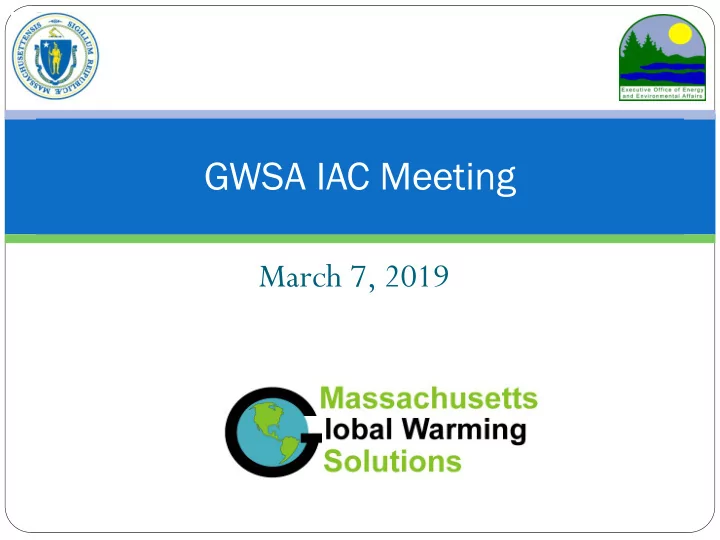

GWSA IAC Meeting March 7, 2019
Agenda Review draft meeting minutes of December 6, 2018 Brief updates from state agencies and IAC working groups Presentation and Q&A of the Commission on the Future of Transportation’s reports Update on the Transportation and Climate Initiative Discussion of the IAC Transportation working group’s policy recommendations for analysis in the 80x50 Study Wrap up, next steps 3/6/2019 2
Slides for IAC transportation policy discussion 3/6/2019 3
Reference Case Transportation GHG Emissions Major Modeling Assumptions Reference Case Transportation GHG Emissions Modest electrification of LDV fleet (~23% by 2050). 40 Minimal electrification and 35 deployment of low-carbon fuels GHG Emissions (MMTCO2e) in heavy-duty fleet. 30 Continued implementation of 25 California and federal fuel Total: 22.2 efficiency standards through Other 2.1 20 mid- 2020’s. Medium/Heavy 8.0 Duty Vehicles 15 Continued growth in total VMT, especially among freight 10 vehicles. Light Duty Vehicles 8.6 Aviation emissions decline from 5 2016 peak but not decline Aviation 3.5 significantly thereafter. 0 1990 2000 2010 2020 2030 2040 2050
Deeper Look at VMT by Mode 2016 VMT Class MOVES Category 2016 VMT Share Type 10 Motorcycles 1,732,118,087 2.9% Type 20 Automobiles 28,708,470,146 47.4% Light Light trucks, e.g., SUVs, Type 30 27,057,539,035 44.7% small pickup trucks Type 40 Buses 147,839,826 0.2% Single-unit trucks, e.g., box Type 50 755,896,553 1.2% trucks, work trucks Heavy Cominbation-unit trucks, Type 60 2,159,704,437 3.6% e.g., 18-wheelers
Reference Case Projections of Heavy-Duty Fleet Energy Consumption, Economy and VMT 150% 900 Percent Change from 1990 (Fuel Economy and VMT) 800 Total Fuel Consumption (million gallons of gasoline Trucks Registered Out of State 100% 700 Combination-Unit Trucks, In-State 600 Single-Unit Trucks, In-State 50% equivalent) 500 Refuse Trucks 400 0% Buses 300 Average Heavy-Duty Fuel 200 -50% Economy Total Heavy-Duty VMT 100 -100% 0 1990 2000 2010 2020 2030 2040 2050
Regional VMT and Population Trends NMCOG MVPC 20.5 VMT 20.4 VMT 5.0% of VMT 5.8% of VMT 4.4% of pop. 5.1% of pop. FRCOG MRPC 23.0 VMT 23.1 VMT 1.4% of VMT 4.5% of VMT 3.5% of pop. 1.1% of pop. Inner Core 10.4 VMT BRPC 12.5% of VMT 16.4 VMT 21.3% of pop. PVPC CMPC 1.8% of VMT Rest of MAPC 16.8 VMT 21.6 VMT 2.0% of pop. 19.1 VMT 8.9% of VMT 10.7% of VMT 29.0% of VMT 9.5% of pop. 8.9% of pop. 27.1% of pop. OCPC 20.8 VMT SRPEDD Massachusetts Totals 5.1% of VMT 20.7 VMT 4.4% of pop. 6.6 million residents 10.6% of VMT 17.8 VMT per resident per day 9.1% of pop. Cape & Islands 22.5 VMT 4.6% of VMT 3.7% of pop.
Population Growth in 2040 NMCOG MVPC +2,000 +31,000 5.2% of pop. 4.1% of pop. 5.7% of growth 0.4% of growth MRPC FRCOG +12,000 -1,000 3.4% of pop. 1.0% of pop. 2.1% of growth -0.1% of growth Inner Core +244,000 BRPC 23.1% of pop. -7,000 45% of growth PVPC CMPC 1.7% of pop Rest of MAPC +20,000 +64,000 -1.2% of growth +158,000 9.1% of pop. 9.1% of pop. 27.3% of pop. 3.7% of growth 12% of growth 29% of growth OCPC +17,000 SRPEDD Massachusetts Totals 4.3% of pop. +19,000 3.2% of growth 7.1 million residents in 2040 8.7% of pop. (8.2% increase, +540,000 residents) 3.6% of growth Cape & Islands -19,000 3.1% of pop. -3.5% of growth
TNC’s statewide public opinion polling (conducted by FM3) of rural residents regarding the future of transportation • Top line outcomes from the polling: – Nine in ten small town and rural Massachusetts voters drive alone two or three times per week, in line with voters nationwide. They largely agree they have no choice but to drive as much as they do ; younger voters are more likely to say that they would prefer to drive less. – Relatively few are interested in an electric vehicle as their next car ; among those in the market for a car, cost, lack of charging infrastructure, and the need for winter-ready vehicles are barriers. – Voters in small-town and rural Massachusetts strongly support the idea of a clean transportation fund , as well as for investments in upgrading infrastructure like roads and bridges, especially those that are climate resilient. – The best arguments for these investments focus on how vulnerable populations would benefit from expanded transportation options. Majorities say that they themselves would not use more transit if their area had it, but they believe more choices would help others. – Funding mechanisms that require companies to pay for their climate impacts are more popular than ones that share the financial burden more broadly – but majorities are willing to pay up to $10 per month personally to support these transportation investments.
Recommend
More recommend